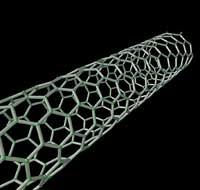Nanomundo of nanotubes
2003/10/01 Rementeria Argote, Nagore - Elhuyar Zientziaren Komunikazioa Iturria: Elhuyar aldizkaria
The theme seems science fiction, currently 40 million transistors enter a seal. It is clear where the limit is, the smallest instruments you can imagine are the molecular ones. But will we be able to get there?
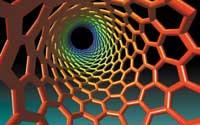
Although for the moment we are quite far from the border, the importance that nanotechnology has acquired gives us an idea of the dimension of the subject. Researchers are increasingly finding applications and movements against nanotechnology have been created, as is often the case with innovative technologies. Those who do not see nanotechnology with good eyes have it as a source of pollution and, before late, ask to investigate the effects that waste generated can have on the environment and human health.
More than dwarf tubes
In spite of the fact that in the 1990s the manufacture of devices at the molecular level was achieved, until 2001 the interconnection of this type of tiny tools was not achieved, thus achieving basic computational operations. Although nanocables from different materials have been used for this purpose, carbon nanotubes are the most loved by researchers.
In fact, carbon nanotubes have very special characteristics, so it is considered that they can have many uses. To begin with, they have an atomic special structure. Nanotubes are carbon formed hexagon networks, rounded in cylindrical form. Depending on the twist of the hexagons, the electrical properties of the nanotube vary, being both conductors and semiconductors.
Balloon initiation
The origin of nanotubes lies in a molecule called fulerene. Fulerenes are carbon molecules with a ball-shaped structure. In it, carbon atoms are grouped into hexagons and pentagons forming a sphere like a football. The diameter of this molecule depends on the number of atoms. The first produced were 60 and 70 carbon atoms, they were the most stable structures, but there are already others of 20, 32, 50 and 540.

Nanotubes have been described as a combination of fulerene and graphite structures, as they are formed by layers such as graphite. These layers are folded in cylinder form and at the edges appear half molecules of fulerene closing the tubes.
Carbon nanotubes can be made up of multiple layers, placed on top of each other as in onions, but they are of a single layer those that are used to make connections in nanocirecids, since the structure of the multilayer nanotubes and therefore the conductivity is very difficult to control. They usually have an approximate diameter of nanometers and must be conductors, of course, but their main characteristic is that they are able to assemble them, so that in the circuit itself they join other nanotubes and other parts.
As can be seen, carbon nanotubes are ideal for the manufacture of molecular chips, but this type of technology is not yet mature and may not be as suitable as it progresses.
At the moment, it seems that nanotubes have a great future. In addition to working nanocables for circuits, they already have other applications. For example, there has been an improvement in resolution on the SPM microscope and the Samsung house has used it on screens with color images.
Uses in the air
In theory most of the properties of nanotubes are known, but in practice some have not yet been tested. However, it is considered that thanks to theoretical calculations, they can have applications in almost all fields.
For example, coating aircraft wings with nanotubes would prevent sparks generated by static energy from causing a fire. Also in aeronautics and astronautics is researching its possible uses in spacecraft. They say that in the future the main components of cars and all types of aircraft will not be metallic, but will be the turn of other materials such as carbon.
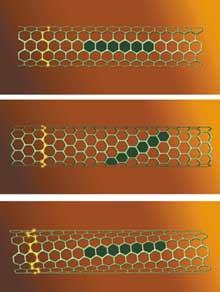
Nanotechnology will also aggravate the textile world. With the fabrics with the interspersed carbon nanotubes will be manufactured the most effective, the most resistant and light anti-bullet garments so far. And, freeing the imagination, we can imagine garments with small computers based on nanotubes, which warn of when they need to be cleaned, or vital constants, for example.
As can be seen, nanotubes have properties that can be useful.
Science fiction?
We will continue to shake the imagination. In a city of the future, a car has gone down, a car has breakdowns but in a few seconds has recovered its initial appearance.
It is possible that in the future this type of car can be manufactured, also with carbon nanotubes. In fact, one of the most striking properties of these tubes is elasticity. Many may be mistaken before breaking, but not only that, they are able to regain the previous aspect once the force that has bent them has stopped. Therefore, if the car body is made with carbon nanotubes, once struck in an accident, they would have an original shape. However, engineers will have to do a lot of work if they don't want cars bounced before, with the force of the blow.
Economy
If that material is so wonderful, why can't we find it in the devices we use every day? The question is simple but the answer is not so much as there is more than one possible answer. Accounts cannot be forgotten. Large quantities of nanotubes have not yet been produced, which means that this is an expensive product, which in recent years is constantly declining. For some applications, the price of carbon fiber would be enough to be economically viable. And over time it does not seem difficult to achieve the goal, since the raw materials used for synthesis are abundant and the synthesis process itself is not expensive.
Therefore, one of the objectives of the researchers is to find a simple way to produce carbon nanotubes in large quantities, that is, to find a way to make the synthesis industrially.
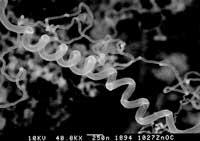
At the moment, three synthesis pathways are mainly used, but two of them are difficult to lead to the industry and the purification of the products obtained is also not easy. The third method consists of the use of natural gas for the preparation of carbon nanotubes, so the synthesis is relatively economical and the quantity of product is easily controllable, but the reaction will require higher performance if you want a cheap product.
On the other hand, it should be noted that nanotube technology is very new, although it is developing very quickly. As a result, all announced uses will hardly be carried out and, at the same time, more applications are expected as research progresses.
The nanomundo of nanotubes is born and the incredible technologies of films and science fiction books are increasingly real. Will reality go further than imagination?
Nanotubes of other materials
Theoretically, nanotubes can be formed by any material with laminar crystalline structure. However, currently the easiest ones to synthesize are those of carbon.
However, other materials such as boron nitride, titanium and boron, carbon and nitrogen combinations are investigated. Especially in the nanotubes of other materials are sought properties that do not have carbon nanotubes.
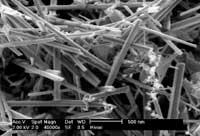
For example, boron nitride nanotubes are very interesting as they all have the same electronic properties. Thus, although they are insulating, they are able to conduct doped electrical current.
Although carbon nanotubes are used to create gas sensors, titanium nanotubes are unique for the manufacture of hydrogen sensors. In addition to being very sensitive, they have seen that they can be used again and again.
Basic research has not yet reached all materials that can form nanotubes, but the patent war has already begun and there is a lot of money at stake.
Characterization and classification of carbon nanotubes
The properties of nanotubes depend on the structure, hence the importance of their structural classification.
To know the structure is measured the diffraction of light of the nanotube. And classification is a consequence of theoretical calculation. Imagine that we cut the links of the nanotube in a straight line parallel to the axis and extend the layer that forms the tube.
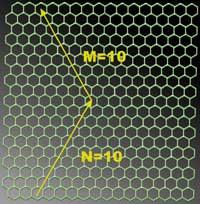
On this surface the vector linking the edges is defined in the case of the figure (N,M) = (10,10).
This vector thoroughly characterizes the tube. Thus, although there may be millions of combinations, a general classification can be made.
- When N=M, the tube is armchair type.
- M=0 in zigzag.
- In all other cases the tube is snail.
Theoretically, armchair type carbon nanotubes are metals in conductivity, while those occupying N-M = 3 are semiconductors and the rest insulating.
Law of Moore Much has been said about the prediction made in 1965 by Gordon Moore, who in two decades said that each year would double the capacity of computers. Later, Moore himself made a correction to this announcement, indicating that the duplication would occur every 18 months. Moore's law has been fulfilled so far, the size of computers has been decreasing exponentially. However, when they start getting transistors of a few nanometers, they try to calculate how long this law will be in effect. In fact, to keep making computers smaller and smaller and that can process higher data densities is essential that they are also cheap, and the technology to make tools so small is, for the moment, very expensive. However, only the future knows what will happen. Computers that contain components of the size of atoms, which are the ones that can be and are the smallest, and will develop sooner or later. As nanotechnology develops, the term of Moore's law will necessarily cease. |

Gai honi buruzko eduki gehiago
Elhuyarrek garatutako teknologia





